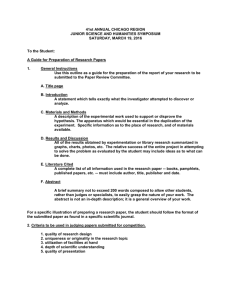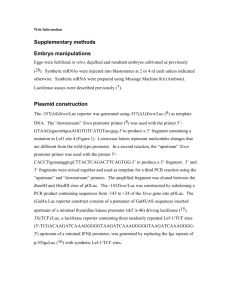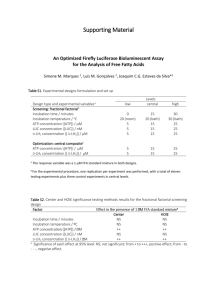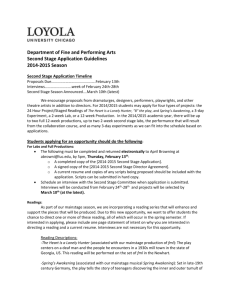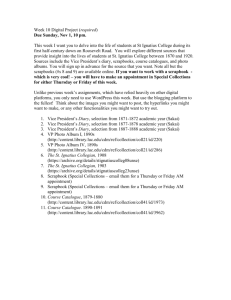Supplementary files:
advertisement
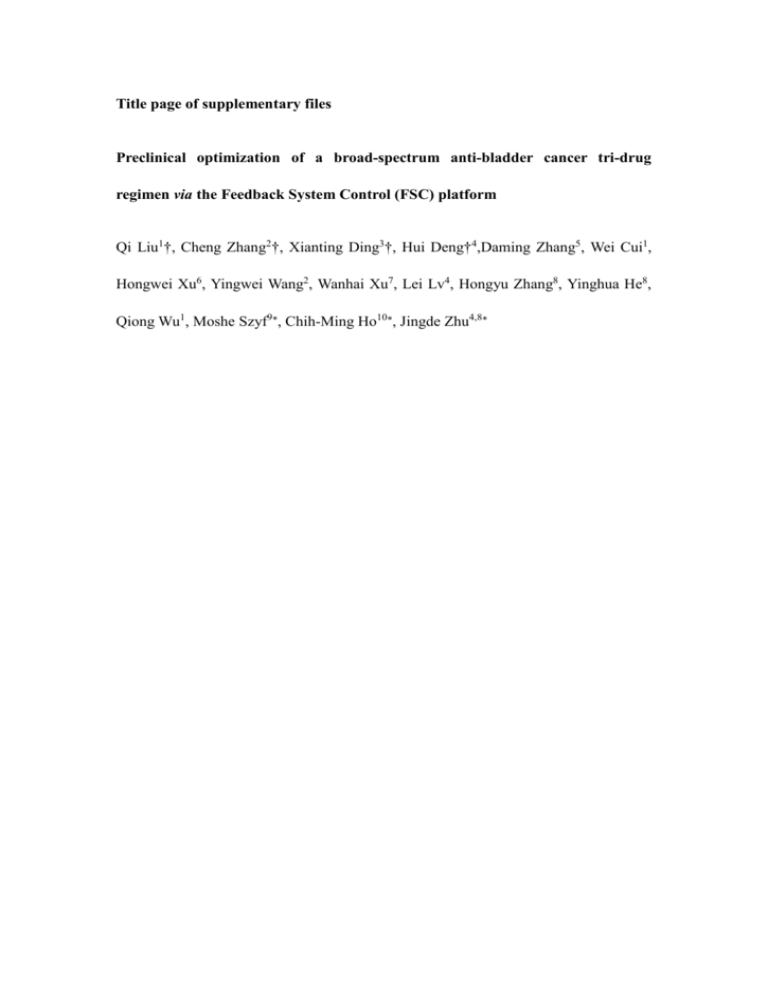
Title page of supplementary files Preclinical optimization of a broad-spectrum anti-bladder cancer tri-drug regimen via the Feedback System Control (FSC) platform Qi Liu1†, Cheng Zhang2†, Xianting Ding3†, Hui Deng†4,Daming Zhang5, Wei Cui1, Hongwei Xu6, Yingwei Wang2, Wanhai Xu7, Lei Lv4, Hongyu Zhang8, Yinghua He8, Qiong Wu1, Moshe Szyf9, Chih-Ming Ho10, Jingde Zhu4,8 Supplementary files list: Supplementary Materials 1. Supplementary figures and tables. Supplementary Materials 2. Differential Evolution search algorithm used in this study. Supplementary Materials 3. Analysis of statistical modeling of four cell lines to decide component drugs for tri-drug combination. Supplementary Materials 4. Use of Feedback System Control (FSC) Platform in the Present Study. Supplementary Materials 1. Supplementary figures and tables. Fig. S1. Step by step illustration of the differential evolution algorithm used in this FSC experiment. Four components are involved: 1. from the drug-dose pool G from the IC50 profiling of BCa cell lines, make up a combination, C 2. measure the i G G efficacy, E(C ), produced by C 3. from the Drug-dose pool, make a mutated i i G G combination, V 4. crossover C i G and V i i G to make up a new combination, U 5. i G G G G measure the efficacy, E(U ), produced by U 6. if E (U ) > E(C ), U i i i G+1 the new drug-dose combination, C i ,and starts the next search. i G i becomes Fig. S2. The number of effective combinations of the 1st to 4th rounds of iterations. Y-axis, the ACS (%). The red line (30%) separates the effective combinations (<30%) from the ineffective (> or = 30%). Fig. S3. Histogram of further experimental testing of the EH/Ci/Mi regimen. The EH/Ci/Mi regimen and five single drugs at a fourfold dose (ng/mL) and the cell survival (%) of each treated cell lines (A) were measured. Therapeutic window (TW) refers to the difference (%) in the treatment trigger cell survival between SV-HUC-1 and BCa cell lines. The therapeutic window index (TW index), referring to the difference (%) between the therapeutic window and the ACS % ranking of the EH/CI/Mi regimen and three component drugs at a threefold higher dose, were also calculated in (A). *, the drug dose was three fold higher than the dose of the same drug in the EH/Ci/Mi combination. **, the therapeutic index= Therapeutic window (%) - ACS% of single drug or EH/CI/Mi regimen. Histogram of ACS, TW, and TW index of the EH/Ci/Mi regimen and each of the three component drugs at a fourfold dose are shown in B. Cell line ATCC Medium + 10% fetal serum (Invitrogen, USA) Description SV-HUC-1 CRL-9520™ Ham's F12 K(5) Normal uroepithelium cell line SCaBER J82 UM-UC-3 T24 5637 HTB-3™ HTB-1™ CRL-1749™ HTB-4™ HTB-9™ MEM MEM MEM RPMI 1640 RPMI 1640 EJ Null RPMI 1640 H-bc Null RPMI 1640 Biu87 Null RPMI 1640 Squamous-cell carcinoma cell line Muscle invasive transitional cell carcinoma line Muscle invasive transitional cell carcinoma line Muscle invasive transitional cell carcinoma line Muscle invasive transitional cell carcinoma line Muscle invasive transitional cell carcinoma line, established by Marshall CJ in 1977 Muscle invasive transitional cell carcinoma line, established by cancer research Institute of Kunming Medical College, 1986 Superficial bladder cancer, established by the Department of Urology of Beijing Medical University in 1987 Table S1. Origin of cells and chemotherapy drugs Combinations 1 2 3 4 5 6 7 8 9 10 11 12 13 14 15 16 17 18 19 20 Pi 8 0.32 40 0.32 8 8 1.6 8 40 0.32 1.6 0.32 1.6 0.32 8 40 1.6 40 40 1.6 Drug Pa 6.4 1.28 6.4 32 1.28 6.4 32 160 1.28 160 1.28 32 1.28 6.4 6.4 160 160 160 32 32 concentration EH 250 10 10 50 2 50 10 250 250 2 10 50 50 250 10 50 250 2 2 2 (ng /ml) Ci 12 1500 12 60 60 300 60 12 12 60 1500 300 300 300 1500 60 12 Ge 0.04 0.04 1 0.04 5 1 0.2 1 0.2 5 5 1 0.04 5 0.2 0.04 0.2 Mi 200 40 40 40 8 40 200 8 8 8 40 1000 8 200 300 1500 1500 5 1 200 1000 1000 1000 0.2 200 1000 5637 41.90 33.17 65.54 54.93 34.82 16.36 38.54 51.28 52.93 36.99 31.49 15.81 65.63 52.51 71.42 32.88 21.63 45.97 19.01 64.95 H-bc 76.86 75.17 73.66 75.43 75.43 67.23 73.62 78.67 76.38 74.87 74.70 65.85 80.87 74.35 78.20 67.23 63.73 69.78 66.02 66.49 Cell Biu87 27.18 24.43 56.05 58.58 36.57 6.60 36.47 59.51 44.11 29.61 12.43 10.97 71.59 44.66 65.15 25.21 7.61 32.88 8.19 56.60 survival EJ 35.64 39.25 41.01 53.31 42.50 31.07 39.52 52.48 37.93 28.92 46.66 43.61 77.21 40.11 67.82 35.57 20.30 38.55 33.46 82.27 (%) J-82 44.07 36.94 54.84 73.33 40.23 20.95 45.53 50.92 55.05 40.77 25.04 15.36 73.49 45.41 70.57 31.63 24.00 40.32 23.62 86.56 T24 51.61 34.64 67.07 53.90 44.68 14.28 40.47 54.26 52.51 38.60 22.32 15.67 75.85 46.27 69.44 34.97 16.44 40.72 23.79 51.16 ACS (%) 46.21 40.60 59.70 61.58 45.71 26.08 45.69 57.85 53.15 41.63 35.44 27.88 74.11 50.55 70.43 37.92 25.62 44.70 29.01 68.01 Table S2. The 2nd round of iteration. The combinations (1-20) varied with the dose (ng/mL) of six drugs and had different effects on cell survival (%). The ACS (%) provides an overall measure of survival of all the cell lines in response to each combination. 1 2 3 Pi 1.6 0.32 40 0.32 0.32 Drug Pa 6.4 160 32 6.4 concentration EH 10 10 50 (ng /ml) Ci 300 1500 Ge 0.2 Mi 8 Combinations Biu87 EJ 6 7 8 9 10 11 8 0.32 8 0.32 40 1.6 6.4 6.4 6.4 6.4 1.28 1.28 2 10 50 10 0 250 60 1500 0 1500 12 1500 0.2 1 1 5 0.2 0.2 40 200 200 29.50 4.79 4 5 1000 1000 1000 19.82 5.84 7.57 12 14 15 16 17 18 19 20 0.32 0.32 40 40 40 0.32 8 1.6 1.6 160 160 160 160 6.4 6.4 32 1.28 6.4 6.4 250 10 50 50 50 50 10 250 50 50 250 300 60 12 60 0 12 1500 12 1500 1500 60 1500 5 5 0.04 0.2 5 5 1 5 5 0.2 5 40 40 8 40 200 1000 200 1000 40 1000 200 13 4.11 42.68 8.50 29.95 41.03 13.56 12.43 17.24 32.23 0.04 0.04 8 200 7.09 29.50 7.69 12.76 71.70 8.87 64.82 38.64 38.32 43.59 59.47 36.31 53.72 51.39 52.79 65.94 43.91 48.97 78.33 48.25 34.98 51.59 30.56 50.82 92.92 29.27 Cell J-82 53.51 1.41 9.69 8.37 0.05 17.42 0.52 3.23 69.57 1.08 survival T24 49.79 9.55 25.80 8.27 14.12 7.94 55.31 7.90 17.90 21.93 15.88 20.25 31.85 31.98 8.60 26.34 10.41 9.75 86.21 9.84 (%) 5637 70.21 80.31 65.63 61.15 59.62 47.02 68.73 82.41 69.40 71.11 50.83 54.02 61.87 57.74 41.50 63.21 26.51 74.52 75.37 62.85 H-bc 51.65 10.95 57.71 8.79 68.66 6.80 73.38 22.34 59.52 45.37 43.16 63.29 71.34 57.27 ACS (%) 0.05 6.01 0.19 22.28 3.47 19.35 28.05 2.99 18.32 36.14 2.25 69.48 0.52 15.02 94.07 1.52 53.25 24.28 36.16 21.28 35.91 17.06 52.68 29.33 41.49 45.57 28.39 36.21 49.46 39.31 15.75 42.92 12.70 27.68 81.64 18.91 Table S3. The 3rd round of iteration. The combinations (1-20) varied with the dose (ng/mL) of six drugs and had different effects on cell survival (%). The ACS (%) provides an overall measure of survival of all the cell lines in response to each combination. Combinations Drug concentration (ng /ml) Cell survival (%) 1 2 3 4 Pi Pa EH Ci Mi Pi 0 0 0 40 40 0 0 0 0 Pa 0 0 160 0 0 160 0 0 0 EH Ci Mi 0 1500 200 250 1500 200 0 1500 200 0 1500 200 0 0 0 0 0 0 250 0 0 0 1500 0 0 0 200 5637 18.3 1.06 7.8 4.36 29.22 6.45 14.75 20.32 53.16 Biu87 13.7 12.5 8.5 12.3 41.67 23.08 38.68 20.94 42.05 J82 17.9 7.26 11.8 7.7 55.37 38.51 45.03 15.42 48.38 T24 15.5 5.82 6.73 10.4 48.33 11.55 20.13 15.46 51.34 EJ 24.85 17.14 18.32 18.01 30.38 33.05 56.55 32.34 45.2 UM-UC-3 13.1 4.2 7.02 8.86 65.59 40.09 43.54 14.71 66.2 H-bc 43.74 0.48 34.73 5.93 86.89 13.96 61.03 41.98 91.67 SCaBER 17.63 3.01 14.22 3.49 30.04 57.91 38.31 22.05 56.83 ACS (%) 20.59 6.43 13.64 8.88 48.44 28.08 39.75 22.9 56.85 Table S4. Further experimental testing of the EH/Ci/Mi regimen (1). The tri-drug combinations (1-4) and five drug at a one fold dose (ng/mL) are indicated and the cell survival (%) of each treated cell line were measured, from which the ACS (%) of each combination was calculated (A). Mock 5637 DNA Damage Hypoxia ER Stress Heat Shock Wnt Notch Cell Cycle/pRb-E 2F Myc/Max MAPK/ERK Negative control Positive control Ci Mi Renluc luc Renluc Relative activity luc EH/Ci/Mi luc Renluc 12536 29072830 0.22 16463 30579432 0.48 17956 34938044 0.63 16120 30098156 0.75 15629 26196576 0.83 1052057 1601415 511659 47316 42575 23600716 31382872 18502666 27569552 21358194 22.72 26.01 14.09 0.87 1.02 1024324 1662012 256314 29940 36939 24274040 31011830 24711858 26540942 23115178 37.36 47.45 9.18 1.00 1.41 1352097 2175983 423550 36165 46653 22097140 32174418 26726118 27194420 25672570 75.18 83.09 19.47 1.63 2.23 808185 1698175 241002 19535 36211 22038922 28112488 23164298 26427688 25995968 51.46 84.76 14.60 1.04 1.95 906153 2088434 433669 20032 55387 22826258 30298250 22347410 22864232 20590916 54.96 95.44 26.87 1.21 3.72 90588 50884692 0.91 118387 59247780 1.77 122055 62526588 2.40 214150 64347208 4.67 141777 56925468 3.45 634048 2257440 29187098 22080312 11.07 52.10 368299 2070782 28010318 20198954 11.64 90.77 475193 2811788 26813652 17753446 21.77 194.59 318318 1226693 26899256 14625057 16.61 117.70 479680 1764958 24095642 15854674 27.56 154.13 46553 23724400 1 29773 26360576 1 19188 23574666 1 14253 20000002 1 15134 20953624 1 2827637 17096506 84.29 3033778 13923928 192.91 2465498 16347385 185.30 1537250 12755471 169.11 2013196 15850561 175.85 luc Relative activity EH Relative activity Renluc Relative activity luc Renluc Relative activity Table S5. The signaling pathway analysis in 5637. The transfection of cells was performed in duplicate. The cell lysate from two transfected cells of the pair were combined for the activities of both firefly luciferase and renilla luciferase genes, which are listed as luc and Renluc in each treatment. Background relative luciferase activities are listed as Mock. Luciferase activities of the EH/Ci/Mi combination versus that by a 4 fold of the single drug: Ci, Mi, and EH are listed in the table. Mock Biu87 Ci Mi Renluc DNA Damage 1170 2227384 1.51 1663 3531196 0.94 2890 5710684 2.03 1470 2834282 1.58 1371 5077079 1.08 Hypoxia 4451 1687236 7.58 7487 1499278 10.01 7691 1144978 26.99 6519 1156255 17.13 9376 936424 40.22 Renluc luc Renluc Relative activity luc Renluc EH/Ci/Mi luc Luc Relative activity EH Relative activity Relative activity luc Renluc Relative activity ER Stress 40626 5327666 21.92 74981 8302932 18.10 44361 4931940 36.14 52055 4349360 36.36 57183 4678703 49.10 Heat Shock 3389 5145078 1.89 9053 6321098 2.87 8222 3842602 8.60 3274 4953542 2.01 2263 3712893 2.45 Wnt 1084 1873321 1.66 1035 3005559 0.69 1100 2497907 1.77 1274 2458774 1.57 852 3350532 1.02 Notch Cell Cycle/pRb-E2F Myc/Max 3188 2067691 4.43 4447 3994370 2.23 4045 2530636 6.42 4323 2210120 5.94 5131 2737670 7.53 1048 5308695 0.57 827 5334082 0.31 792 3836588 0.83 3978 5391695 2.24 751 6701679 0.45 6849 2405994 8.18 10012 4361355 4.60 9217 3901945 9.49 13337 2976075 13.61 14966 3270559 18.38 MAPK/ERK 219738 1289376 489.80 223810 1396421 321.19 454932 1824789 1001.57 402732 2011157 608.33 210769 1578983 536.23 2475 7113303 1 3696 7406714 1 2398 9633820 1 2575 7822520 1 2087 8383868 1 111213 1913179 167.07 137362 1480354 185.95 123326 1627869 304.36 156600 1862408 255.44 194031 1520161 512.75 Negative control Positive control Table S6. The signaling pathway analysis in Biu87. The transfection of cells was performed in duplicate. The cell lysate from two transfected cells of the pair were combined for the activities of both firefly luciferase and renilla luciferase genes, which are listed as luc and Renluc in each treatment. Background relative luciferase activities are listed as Mock. Luciferase activities of the EH/Ci/Mi combination versus that by a 4 fold of the single drug: Ci, Mi, and EH are listed in the table. Mock UM-UC-3 Ci luc Renluc Relative activity luc Mi Renluc Relative activity luc 2147032 2.38 EH Renluc Relative activity luc 8237 1502130 4.77 EH/Ci/Mi Renluc Relative activity luc Renluc Relative activity 9467 1431776 5.96 8320 1524256 5.42 DNA Damage Hypoxia 5855 1472476 3.49 5325 33444 468141 62.72 25797 594608 41.68 29511 558774 45.95 39411 480634 73.93 29518 506501 57.87 ER Stress 91342 982640 81.61 71599 1019011 67.50 81715 648793 109.59 114029 849848 120.98 63215 948602 66.17 Heat Shock 929 187527 4.35 550 154516 3.42 1002 216089 4.03 536 164788 2.93 338 160863 2.09 Wnt 2272 555610 3.59 1099 610446 1.73 2244 480824 4.06 2599 568504 4.12 1253 430152 2.89 Notch Cell Cycle/pRb-E 2F Myc/Max 23352 4144667 4.95 20903 4021789 4.99 22993 2702600 7.40 34486 3060547 10.16 26857 3559553 7.49 1230 181856 5.94 561 234963 2.29 787 315046 2.17 3739 195419 17.25 1292 215829 5.94 21009 316030 58.37 11423 449464 24.42 11805 458417 22.41 15832 560204 25.48 12508 303171 40.97 MAPK/ERK 93465 576801 142.27 54365 724900 72.05 96470 554587 151.35 134413 661484 183.22 70680 644165 108.95 11172 9808636 1 10236 9833868 1 10178 8855745 1 10475 9444867 1 9389 9322670 1 309127 2534228 107.09 266403 2002668 127.80 219764 2347988 81.44 328077 2808991 105.31 319831 2468161 128.67 Negative control Positive control Table S7. The signaling pathway analysis in UM-UC-3. The transfection of cells was performed in duplicate. The cell lysate from two transfected cells of the pair were combined for the activities of both firefly luciferase and renilla luciferase genes, which are listed as luc and Renluc in each treatment. Background relative luciferase activities are listed as Mock. Luciferase activities of the EH/Ci/Mi combination versus that by a 4 fold of the single drug: Ci, Mi, and EH are listed in the table. Mock H-bc Ci luc Renluc Relative activity luc Mi Renluc Relative activity luc 4.19 EH Renluc Relative activity luc 1185 1990956 0.73 EH/Ci/Mi Renluc Relative activity luc Renluc Relative activity 2158 692083 3.99 2227 1073909 1.47 DNA Damage Hypoxia 2015 3432545 0.80 1546 1281912 93683 3105480 41.20 106095 7500511 49.11 108144 6568317 20.08 128282 2852609 57.60 151139 6899389 15.49 ER Stress 94542 4743843 27.22 163717 5594167 101.61 239204 6560323 44.48 181107 8106904 28.61 223897 10687862 14.81 Heat Shock 4692 1440244 4.45 8865 1886689 16.31 4846 5282890 1.12 4438 1818590 3.13 4225 1753539 1.70 Wnt 4284 4474023 1.31 5450 6023579 3.14 5492 11151935 0.60 7571 8824576 1.10 6611 6578338 0.71 Notch Cell Cycle/pRbE2F Myc/Max 1607 1298732 1.69 2219 4825030 1.60 1832 3790065 0.59 2986 1741009 2.20 2697 3162138 0.60 10459 3833178 3.73 11455 6792549 5.86 12829 17003119 0.92 17368 5010011 4.44 12065 4671758 1.83 89185 7685777 15.85 120068 8299990 50.23 86926 10750527 9.86 92499 6723079 17.62 86003 2918818 20.84 MAPK/ERK 239072 2086866 156.44 290167 2958210 340.57 325601 6723697 59.07 331906 4467438 95.16 393552 5160822 53.92 703 959998 1 954 3312384 1 914 1114948 1 838 1073349 1 724 511956 1 22609 2499255 12.35 14602 2857566 17.74 18615 6370362 3.56 13915 2479590 7.19 20173 1489971 9.57 Negative control Positive control Table S8. The signaling pathway analysis in H-bc. The transfection of cells was performed in duplicate. The cell lysate from two transfected cells of the pair were combined for the activities of both firefly luciferase and renilla luciferase genes, which are listed as luc and Renluc in each treatment. Background relative luciferase activities are listed as Mock. Luciferase activities of the EH/Ci/Mi combination versus that by a 4 fold of the single drug: Ci, Mi, and EH are listed in the table. Mock SV-HUC-1 DNA Damage Ci Mi EH EH/Ci/Mi luc Renluc Relative activity luc Renluc Relative activity luc Renluc Relative activity luc Renluc Relative activity luc Renluc Relativ e activity 65065 26021553 2.40 67503 24632906 3.70 281508 31469814 4.20 310089 31955895 6.00 389590 26547677 5.60 Hypoxia 556794 21123753 25.30 437361 19553671 30.20 2225553 19903601 52.50 1665093 23399224 44.00 2546002 23132188 42.00 ER Stress 2999614 28089149 102.50 2127729 24981219 115.00 9579549 28980528 155.20 14481584 29847666 300.00 12552116 30704324 156.00 Heat Shock 683248 16560758 39.60 542556 19906350 36.80 2050872 24073070 40.00 1431915 24594061 36.00 2492592 22646922 42.00 Wnt 31879 24676048 1.24 24544 21379748 1.55 83472 24494884 1.60 58993 28058876 1.30 91080 23170671 1.50 Notch 85641 19116590 4.30 85503 18620163 6.20 201928 23124105 4.10 249971 27600509 5.60 278882 20866887 5.10 Cell Cycle/pRbE2F 232505 45544197 4.90 296922 47726361 8.40 815673 56319698 6.80 1325887 68318891 12.00 1058228 57688414 7.00 Myc/Max 2999310 26123828 110.20 1833224 22563387 109.70 8230355 24151914 160.00 5773588 28559550 125.00 6399018 24418585 100.00 MAPK/ERK 4857155 19762919 235.90 4687804 16271033 389.00 11409592 15991097 335.00 5650354 15527755 225.00 10105164 16067167 240.00 Negative control 22123 21234456 1.00 15727 21234456 1.00 45226 21234456 1.00 34342 21234456 1.00 55646 21234456 1.00 Positive control 1992811 15302179 125.00 1287610 11216259 155.00 6679909 14724613 213.00 3854825 13542773 176.00 7450625 16062999 177.00 Table S9. The signaling pathway analysis in SV-HUC-1. The transfection of cells was performed in duplicate. The cell lysate from two transfected cells of the pair were combined for the activities of both firefly luciferase and renilla luciferase genes, which are listed as luc and Renluc in each treatment. Background relative luciferase activities are listed as Mock. Luciferase activities of the EH/Ci/Mi combination versus that by a 4 fold of the single drug: Ci, Mi, and EH are listed in the table. Supplementary Materials 2: Differential Evolution search algorithm used in this study There are three calculations steps in the DE search algorithm: “Mutation”, “Crossover” and “Selection” calculations, used together to suggest the list of the options to be tested in the remaining three round screenings (Fig. 1). The drug combination in the trial group was calculated, according to the mathematical equation below: where a “Mutation” calculated drug combination, , , represents are different random drug combinations from the trial group. This process was repeated twenty times to generate twenty “Mutation” drug combinations, which were tested in cell lines for their treatment-trigged cell death (iteration 1). The next calculation is called “Crossover” calculation, equations: which is based on the , where following set and of mathematical means the drug and dose in “Mutation” drug combinations and trial group, respectively, means the drug and dose in the “Crossover” calculated drug combinations. This calculation was repeated for each drug in the “Mutation” drug combinations to generate twenty “Crossover” drug combinations (also named the test group,) (Step 2), which were experimentally tested (iteration 2). In the “Selection” calculation, the drug-triggered cell death of trial groups (iteration 1 and 2 were compared, based on the following calculation: , where Xi,j represents the drug combinations in the trial group and Ui,j represents the drug combinations in the test group. Drug combinations with better efficacy were left for further consideration via the same calculation process to again generate a new test group. Supplementary Materials 3: Analysis of statistical modeling of four cell lines to decide component drugs for tri-drug combination After four rounds of drug combination optimization experiments under the guidance of the Feedback System Control (FSC) approach, the linear regression statistical modeling for the following four cell lines was built: Biu87, H-bc, 5637, and UM-UC-3 The linear regression model for Biu87 was: , where Biu87ACS represents the average of accumulated cell survival (%) of Biu87 cells under drug treatment. Pi, Pa, EH, Ci, Ge, and Mi in the equation represent the absolute dosages of each drug (ng/mL). The model had a R2 value equals to 0.7015 and p-value equals to 2.439e-15, which indicated a fairly good fit between the model and real experimental observations. Ge had a negative linear regression coefficient but largest positive quadratic regression coefficient, which means the dose increase of Ge is less likely to positively contribute to the drug-triggered cell death when it is used in combination with other drugs. Ge also had the largest positive two-drug interaction coefficient with Mi, meaning in the presence of Mi, Ge could have an antagonistic effect in reducing cell survival. Therefore, we confidently eliminated Ge from further study. The regression model for the H-bc cell line was: For the H-bc cell line, only Ci and Mi were left in the final regression model and the rest of the drugs did not appear in the model. The interaction coefficient was negative, suggesting a synergistic effect could exist between the two drugs in treating the H-bc cell line, indicating that Ci and Mi were the most dominant drugs in treating the H-bc cell line. The model for cell line 5637 was : ; For cell line 5637, only EH and Mi were left in the final regression model, suggesting EH and Mi were the most effective drugs in treating cell line 5637. The model for the UM-UC-3 cell line was: UM-UC-3 ACS For the UM-UC-3 cell line, all six drugs showed negative coefficients, meaning as a single drug, they all should contribute to the reduction of UM-UC-3 growth. However, the interaction coefficients were all positive, which indicated that when accumulative drug doses start to increase, especially when the drug doses are high enough, the contribution of drug synergy are not clearly observed in the mixture of the six drugs. Another way to interpret this is that when treating UM-UC-3, a subgroup of the six drugs may be no worse than the combination of the six drugs. Furthermore, Pa and Pi showed a very large positive interaction coefficient, Pa also showed a very large quadratic coefficient, so Pa and Pi were used in combination for the UM-UC-3 cell line. Since EH, Ci, and Mi were most commonly seen drugs in all the models, based on the statistical analysis discussed above, a tri-drug combination EH/Ci/Mi was confirmed for further investigation in our study. Supplementary Materials 4. Use of Feedback System Control (FSC) Platform in the Present Study Feedback System Control (FSC) is a platform technology for rapid identification of optimal drug combinations. FSC consists of three iterative operations: 1) suggesting candidate drug combinations, 2) acquiring readouts of each combination experimentally, and 3) optimizing the combinations through an engineering feedback system control algorithm (1, 2). Compared to the conventional experimental setups where high-throughput tests are often included, the FSC approach tests only a small number of drug combinations (usually less than 25) per iteration and optimizes them iteratively. Usually, the optimal solution for the system can be identified in no more than 20 iterations by testing 0.1~1% of the total possibilities. The FSC technique has been verified in multiple systems, including viral inhibition (1), human ES cell maintenance (3), and Chinese herbal medicine (4). In this project, we aimed to apply the FSC strategy to optimize 8 chemo-drugs for 8 cell lines. An illustrative scheme is shown in Fig. 1. The success of the FSC scheme highly relies on system readouts that closely imitate the ideal biological activity. The readouts should fairly indicate the efficiency of the therapy, in our case, the suitable and differential lethal rate for different cells. The potent drug combination(s) that could kill most cancer cells with the least side effect on the normal cells was our goal. In order to decide on a reasonable dose range of each drug to be studied, the IC 50 profiles of all 8 cell lines were first established. Each drug was designated with five doses which differed by 5 fold to cover most of the range from 0 up to IC50 dose. The first batch of drug combinations to be tested were randomly generated through a random number generator written in MATLAB language (MathWorks©, Natick, MA, U.S.). The engineering feedback algorithm in this study was Differential Evolution, a robust search algorithm that had previously been verified in a viral inhibition system(1). Reference 1. X. Ding, D. J. Sanchez, A. Shahangian, I. Al-Shyoukh, G. Cheng, C. M. Ho, Cascade search for HSV-1 combinatorial drugs with high antiviral efficacy and low toxicity. International journal of nanomedicine7, 2281-2292 (2012). 2.P. K. Wong, F. Yu, A. Shahangian, G. Cheng, R. Sun, C. M. Ho, Closed-loop control of cellular functions using combinatory drugs guided by a stochastic search algorithm. Proceedings of the National Academy of Sciences of the United States of America105, 5105-5110 (2008). 3.H. Tsutsui, B. Valamehr, A. Hindoyan, R. Qiao, X. Ding, S. Guo, O. N. Witte, X. Liu, C. M. Ho, H. Wu, An optimized small molecule inhibitor cocktail supports long-term maintenance of human embryonic stem cells. Nature communications2, sixteen7 (2011). 4.H. Yu, W. L. Zhang, X. Ding, K. Y. Zheng, C. M. Ho, K. W. Tsim, Y. K. Lee, Optimizing combinations of flavonoids deriving from astragali radix in activating the regulatory element of erythropoietin by a feedback system control scheme. Evidence-based complementary and alternative medicine : eCAM2013, 541436 (2013).

